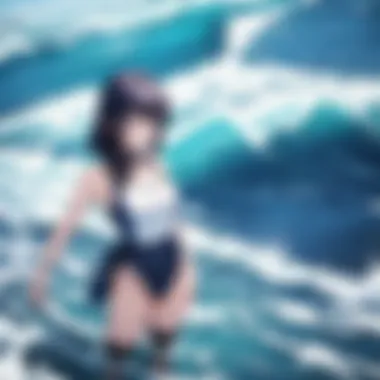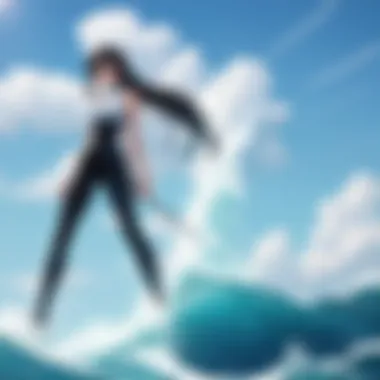Exploring 'Ride Your Wave': An In-Depth Analysis


Prologue to 'Ride Your Wave'
The anime film 'Ride Your Wave' presents an intriguing blend of romance and fantasy, exploring profound emotional landscapes through its compelling narrative. It stands out within the animated medium due to its unique approach towards love, grief, and the transient nature of experiences. In this section, we will delve into its foundational elements, which facilitate a comprehensive understanding of its themes and characters. By investigating aspects such as character dynamics and thematic relevance, readers will gain insights into how this film resonates within contemporary anime and its emotional impact on audiences overall.
Overview of the Film
'Ride Your Wave,' directed by Masaaki Yuasa, presents itself not simply as a romance but as a deep reflection on the healing power of love and the ways in which we cope with loss. The narrative centers around Hinako, a college student passionate about surfing. Portraying her adventures through passion and heartache, we see the highlight moments in her life unfold. When tragedy strikes, the intersection of memory and formless desire is deeply felt; the film allows a potent examination of how love transcends the confines of reality, adding a striking layer to the viewing experience. Elements such as vibrant animation and distinctive visual storytelling further empower its plot, ensuring that it is not only about characters’ emotional turmoil, but also about the mood expressed through art.
Key Themes and Concepts
The central themes in 'Ride Your Wave' revolve around the concepts of love, loss, and resilience. The film urges viewers to contemplate the following:
- Coping with Grief: The narrative illustrates how personal loss can reshape one's view of relationships and self. The metaphor of riding waves encapsulates the journey of navigating through emotions.
- The Nature of Memory: Memory plays a crucial role as characters engage with past experiences, enabling sharing stories beyond physical presence. This understandably resonates with audiences who have faced heartbreak themselves.
- Recovery through Dream: Beyond the pain of loss, there's an underlying message of hope and reliance on joyful memories that buoy individuals back to their being.
The film creatively combines light moments with deeply serious observations of life, blurring lines in a compelling story that lasts in the memory of the viewers. This section provides a strong inference into understanding the broader impact of 'Ride Your Wave' in animation culture and its relevance today. The mentioned themes lay the groundwork for dialogue on emotional narratives within romantic developments.
Plot Summary
The plot summary provides a critical framework for understanding the narrative structure of Ride Your Wave. It highlights essential developments and shifts in the storyline that contribute to the film's emotional resonance and thematic depth. Analyzing the plot allows viewers to appreciate character motivations, relationship dynamics, and what drives the narrative to its culmination. This section serves both dedicated fans seeking deeper insights and newcomers aiming to grasp the essential storyline.
Initial Setup
In Ride Your Wave, the initial setup establishes a blend of ordinary life and the unusual. The protagonist, Hinako, is a college student and surf enthusiast whose life becomes intertwined with that of a fireman, Wataru. This connection forms the backbone of the film's heartbeat. Their burgeoning romance unveils a tableau of youth, dreams, and personal aspirations. The initial scenes depict aesthetic elements that resonate with the audience, allowing viewers to see not only the lives but also the aspirations of the characters. The surf culture becomes symbolic in framing their relationship, indicating freedom, exploration, and the pursuit of joy amid challenges.
Climactic Moments
The climactic moments of the film pivot around an unforeseen tragedy. This event is a turning point that shifts the dynamics of Hinako and Wataru’s relationship. The emotional build-up is palpable when the characters face pivotal decisions. This segment reflects profound feelings of loss, denial, and heartbreak that resonate with the audience. The narrative does not shy away from showing the realism of grief and the courage needed to confront it. Such moments compel viewers to reflect on the fragility of life and relationships. The surf, again, serves both as a haven and a battleground for emotions, anchoring the audience's emotional involvement.
Resolution and Ending
The resolution in Ride Your Wave offers a bittersweet moment of acceptance. After wrestling with her emotions, Hinako learns to cherish memories while moving forward. The final scenes encapsulate a sense of hope. There is no simple fix to the sorrow, but the film emphasizes the possibilities that life continues to present. This ending sparks discussions about healing and resilience. It leaves the audience with a recognition that while loss is a part of life, so is love, hope, and the potential for renewal. The seamless merging of this resolution with ongoing visual motifs—water, surf, and movement—invites viewers to internalize the film's core message.
The true art of Ride Your Wave lies in its ability to depict how people navigate love, loss, and life in all its complexity.
Character Analysis
Character analysis is a crucial element in exploring 'Ride Your Wave.' Each character drives the narrative and embodies the film's central themes. Understanding these characters enhances recognition of their emotional complexities and motivations. This segment encourages deep comprehension of essential aspects such as relationships, individual growth, and pertinent choices made through the storyline.
Main Characters
The film centers on two primary characters: Hinako Matsuda and Wave. Hinako is a passionate college student with a love for surfing. She represents aspiration and determination. Despite her upbeat attitude, trauma from the past profoundly affects her actions and relationships. In contrast, Wave thrives on love and joy of living. His relationships add richness to the plot, and his destiny leads to Hinako's transformation.


These characters are depicted vividly, allowing the audience to interact deeply with their struggles. Hinako must contend with loss and self-discovery after Wave's accident. This journey provides vital commentary on coping, attachment, and the healing process.
Supporting Characters
The supporting characters enrich Hinako and Wave's narrative. They offer different perspectives and contribute to the emotional depth of the film. For example, Hinako's friend, who is characterized by loyalty, becomes crucial in guiding Hinako through her challenges. Similarly, the personality traits of individuals in her circle keep the narrative grounded in reality.
These supporting roles serve a dual purpose. They not only assist in revealing the personalities of the main characters but also introduce different societal influences and cultural contexts surrounding the two leads.
Character Development Arcs
Character arcs in 'Ride Your Wave' convey the fundamental growth experienced throughout the film. Hinako, evolving from a dependent individual to a self-aware person, showcases resilience. She transforms her pain into empowering inner strength.
A noticeable shift occurs when hardship prompts character reevaluation. With each event, both from humorous and tragic angles, her journey is filled with relatable emotions. Progressively, she adjusts her approach to relationships and understandings about love and loss. The ultimate arc highlights how one's experiences forge the depth of character.
In summary, character analysis in 'Ride Your Wave' reveals layers of meaning and emotional depth that resonate deeply with audiences. These explorations enrich the viewing experience, shedding light on timeless themes of love, loss, and healing.
Visual and Audio Design
Visual and audio design play critical roles in shaping the viewer's experience of Ride Your Wave. These elements not only create a captivating aesthetic but also reinforce the narrative and emotional themes inherent in the film. The fluid animation, carefully curated score, and symbolic visuals all contribute to the depth of storytelling, helping audiences to engage more meaningfully with the characters and their journey.
Animation Style
The animation style in Ride Your Wave stands out as a hallmark of contemporary anime artistry. The character design is rich and expressive, drawing the viewer into every emotion conveyed. Fluid movements replicate real-life surf techniques while providing a sense of freedom and escapism.
Colors play a vital role as well. Vibrant hues used during joyful moments starkly contrast with muted tones that accompany sorrow. This shift visually represents the emotional dilemmas the characters face. Consistently, the ocean waves are depicted with an enchanting detail that showcases both beauty and turbulence, reflecting the film's themes of love and loss.
Soundtrack and Score
Sound is an essential, often overlooked, component of anime films. Ride Your Wave features an impressive soundtrack that enhances its storytelling. The score, mainly composed by Masaru Yokoyama, complements the moods and emotions presented on screen. Melodies swell during climactic scenes, creating a palpable tension that pulls the audience into the characters' struggles.
Furthermore, the use of sound design adds layers to the narrative. The gentle sound of waves crashing or the bustling ambiance of seaside towns competes harmoniously with the score, creating a rich auditory landscape. Lyrics in certain musical pieces encapsulate the feelings of the characters, providing insightful context. This synergy between the visual elements and the audio gives depth to every moment.
Symbolic Visuals
Symbolism ingrained in visuals elevates Ride Your Wave beyond a simple love story. The ocean is a powerful metaphor throughout the film, representing both life's ebb and flow as well as the tumult of human emotion. Water symbolizes purification and rebirth, while fire— evoked in certain key scenes—embodies passion and fleeting moments of passion that cannot last indefinitely.
Elements like the recurring motif of the surfers further delve into themes of connection and separation. Each wave they bravely confront can be viewed as a metaphor for the hurdles in their personal lives. Ultimately, these symbolic visuals provide a deeper understanding of the characters’ journeys.
“Visual storytelling can convey emotions that dialogues alone cannot express.”
Cultural and Social Context
Understanding the cultural and social context surrounding Ride Your Wave is essential for appreciating its deeper themes and impact. By examining the elements representative of contemporary society, we illuminate how the film resonates with audiences today. This aspect of the analysis reveals the influences that have shaped its narrative, the character's journeys, and its broader implications within anime and romance genres.


Cultural Significance
Ride Your Wave is not just a visual and emotional spectacle; it also reflects significant cultural motifs. The film navigates themes of love, loss, and acceptance, drawing from Japanese societal values. These principles intertwine with the narrative, portraying how individuals cope with grief and harness memories, creating a collective identity. The way characters handle their emotions illustrates mono no aware, a concept appreciating transient beauty. Moreover, water serves not just as a setting but a metaphor, hinting at spiritual rebirth or cleansing, pervading aspects of Japanese culture.
Key Points:
- Themes of love and bring seen as the tide of life: The artist convey strong emotional connections, shaped by how society views relationships.
- Portrayal of modernity vs. tradition: Conflicted values underpin characters' decisions, reflecting contemporary challenges.
- Emotional resonance: The film deserves a study for how it connects on a personal, cultural level.
Comparison with Other Works
When drawing comparisons, Ride Your Wave can be viewed alongside pieces like Your Name and A Silent Voice. Each of these films tackles perceptions of love and human connection but diverges in approach.
Your Name centers on fate and cosmic interplay, highlighting serendiptious moments leading to personal growth. Although it involves supernatural elements, it revolves around the grounding elements of personal fulfillment and social connection.
Conversely, A Silent Voice presents generational trauma and the responsibilities of youth, ingesting discussions on bullying and acceptance. Ride Your Wave unfurls in opposing emotional tones, often depict grief and intimacy, through anime’s recurring motifs.
Similarities worth noting:
- Centrality of nature as a character's emotional guide
- Strong character developments that reflect personal struggles
- Overall artistic fluidity interconnecting life and art.
Influences and Inspirations
Ride Your Wave is woven with inspirations from various artistic real-life sources, history, and traditional Japanese artwork. Its creator, Masaaki Yuasa, integrates his visionary storytelling style; echoing works such as Shoji Otomo's Akira. Also, blends modern anime trends with a unique perspective, inviting a reassessment of anime romances.
Recognifiable influences include:
- Literary Sources: Existential authors like Haruki Murakami’s emphasis on connection and isolation shape character motivations.
- Cultural Art: Displays of kintsugi, reflecting beauty in brokenness mirrors character arcs; they confront loss.
- Emerging role of social media: Influences perceptions and relationship-building.
Audience Reception
Understanding the audience reception of Ride Your Wave is crucial in grasping its overall impact. Audience reception encapsulates how viewers interact with the film, their thoughts, emotions, and feedback. This examination sheds light on the film's resonance and provides insights into its broader significance in contemporary anime, especially within the romantic drama genre.
Critical Acclaim
Ride Your Wave received substantial critical acclaim upon its release. Critics praised the film for its emotive storytelling and captivating animation. Reviewers often highlighted how the direction by Masaaki Yuasa elevates the narrative, making it a profound experience. Notable critics, such as those from The Japan Times and Variety, have commended the film's unique blend of humor, heart, and surrealism, creating multi-dimensional characters that support the emotional gravity of the plot.
Many analysts appreciated the balance of themes like love, loss, and resilience without resorting to excessive melodrama. The artistic merit is undeniable, making it an essential reference point in discussions about modern animation techniques. These accolades play a vital role in positioning Ride Your Wave as an important work that challenges traditional narratives in anime, showcasing its artistic depth and appeal to global audiences.
Fan Reactions
Fan reactions offer a rich tapestry of perspectives that contribute significantly to understanding Ride Your Wave. Many viewers expressed personal connections to the film's themes, sharing their experiences and interpretations online. Platforms such as Reddit and various anime forums bustled with discussions illuminating the emotional underpinnings found in Rijde Your Wave.
Fans resonated particularly with the protagonist's struggles and emotional journey, mirroring their experiences of love and longing. Some noted how the film navigates complex emotions such as grief and hope, provoking thoughtful discourse. Social media platforms like Twitter showed a surge of fans sharing moments and fan art, indicating a strong community engagement. Overall, the enthusiastic responses illustrate that the film has transcended entertainment, becoming a part of personal narratives among its viewers.


Awards and Recognitions
The accolades for Ride Your Wave extend beyond critical acclaim and fan engagement. The film has garnered several nominations and awards, solidifying its place in the annals of influential anime. It achieved recognition at various film festivals, indicative of its artistic relevance and cultural impact.
Representing significant milestones:
- The 2020 Animation of the Year at the Japan Academy Prize
- Best Animation Feature at the Tokyo Anime Award Festival
These achievements serve as a testament to its exceptional storytelling combined with stunning animation. The recognition not only underscores the film's qualitative aspects but also emphasizes its role in promoting anime as a legitimate and respected form of artistic expression. The awards have created extended discussion within academic and critical circles about the evolving landscape of animated storytelling in Japan.
'Ride Your Wave is a gripping exploration of how love persists beyond sorrow. Its distinctive style feeds into its potent narrative, causing ripples beyond the realm of animation.' - Anime News Network
End
Overall Impact of 'Ride Your Wave'
'Ride Your Wave' significantly affects both viewers and the anime medium itself. The film combines vibrant storytelling with profound emotions. This duality allows audiences to explore complex themes such as love, loss, and resilience in unique ways. The significance of water as a recurring motif intertwines the narrative, representing fluidity and change. Such elements invite the audience to confront their perceptions of relationships and connection, evoking a more intense reaction rather than superficial engagement.
Moreover, the emotional gravity seen in Ride Your Wave reflects current societal issues and personal challenges. The film manages to bridge personal and global emotions. It includes moments laced with existential dread while also featuring hope and love. This complex approach to storytelling opens up possibilities for introspection, not often achieved in typical romantic dramas.
Future Implications for Anime
The success of Ride Your Wave sets precedents for future anime productions. From integrating romance with deeper life themes to enlightening approaches to storytelling, it encourages other creators to venture beyond formulas. The culture surrounding anime continuously evolves, and films like this push animation toward mainstream acceptance for complex narratives.
As anime grows as a cultural phenomenon, the emphasis on storytelling should become a priority. Expect more animators to tackle intricate narratives with emotional depths akin to, or inspired by, this film. Innovations in technology may also play a role in enhancing visual storytelling, particularly in anime, striking new chords with audiences. By acknowledging personal challenges of characters, there may come increased audience empathy resembling moods suggested in classic literature.
In summary, Ride Your Wave not only stands as a remarkable film but also exemplifies what future works can embrace in terms of depth and substance, fortifying anime's position as a versatile art form appealing to broader audiences.
Further Reading and Resources
In order for readers to enhance their understanding of 'Ride Your Wave', exploring relevant material is essential. This section provides a selection of valuable resources, which will help deepen insights into the film and its broader implications in the world of anime and beyond. Engaging with these resources enriches one’s appreciation, from scholarly interpretations to interviews with the creators. Understanding where to seek out information shapes the conversation around a piece of art, offering various weights to different voices speaking about similar themes.
Academic Articles
Academic works can offer critical theories and analyses concerning 'Ride Your Wave.' They often delve into aspects such as narrative structure, gender representation, and the overarching thematic elements of love and loss. Academic articles will typically include:
- Peer-reviewed insights which can provide depth to observations made within the film.
- Exploration of genres, including a discourse on how this film fits within the romantic drama framework in anime.
- Analytical perspectives connecting the film to cultural phenomena, considering the influence of Japanese culture in storytelling and character development.
For instance, articles published in journals like the International Journal of Asian Studies or the Journal of Screenwriting often present extensive, evidence-driven evaluations which elevate casual viewers' understanding into a more knowledgeable appreciation. A deeper inquiry into specialized topics lends richness to one's viewing experience.
Documentaries and Interviews
Accessing interviews from developers and documentaries about the film provides unique insights into the intent behind the art. Often overlooked, these resources can present narratives not seen in the final product.
- Interviews with directors and writers reveal thought processes that shaped character arcs and plot developments.
- Documentaries covering the making of the film may take the viewer into the animation process, giving an appreciation for the complexity and collaboration involved.
- Industry expert commentary can provide broader frameworks, helping establish connections between 'Ride Your Wave' and significant trends in contemporary anime.
Fundamentally, these resources invite discussion and thought for anyone enjoying 'Ride Your Wave', assisting in building connections beyond surface-level engagement. Recognizing lesser-known insights ensures individuals navigating this film richly engage with the content, thus enhancing their overall experience.
"A great film is multilayered, serving multiple interpretations for different audiences. Engaging with supplementary material gives viewers another lens to examine in deeper facets of the narrative."







